小学英语单词分类+语法时态汇总
(最新版)小学英语语法八大时态总结
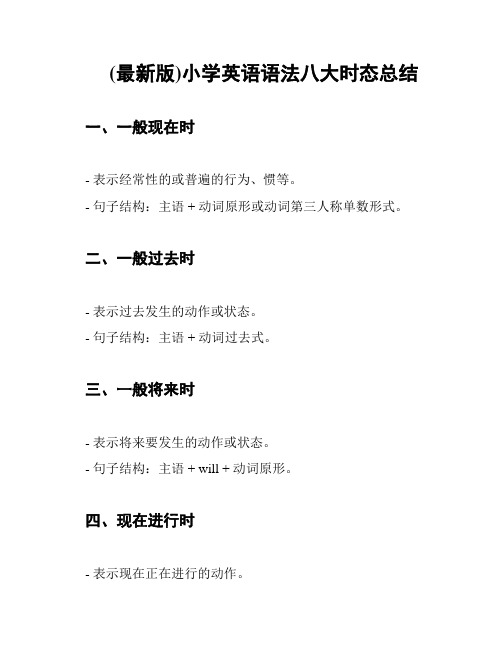
(最新版)小学英语语法八大时态总结一、一般现在时
- 表示经常性的或普遍的行为、惯等。
- 句子结构:主语 + 动词原形或动词第三人称单数形式。
二、一般过去时
- 表示过去发生的动作或状态。
- 句子结构:主语 + 动词过去式。
三、一般将来时
- 表示将来要发生的动作或状态。
- 句子结构:主语 + will + 动词原形。
四、现在进行时
- 表示现在正在进行的动作。
- 句子结构:主语 + am/is/are + 动词-ing。
五、过去进行时
- 表示过去某个时间正在进行的动作。
- 句子结构:主语 + was/were + 动词-ing。
六、将来进行时
- 表示将来某个时间正在进行的动作。
- 句子结构:主语 + will be + 动词-ing。
七、现在完成时
- 表示过去发生但与现在有关的动作或经历。
- 句子结构:主语 + have/has + 动词过去分词。
八、过去完成时
- 表示过去某个时间之前已经发生的动作。
- 句子结构:主语 + had + 动词过去分词。
以上是小学英语语法八大时态的总结,希望能对同学们的研究有所帮助。
小学英语语法动词时态总结

小学英语语法动词时态总结一、一般现在时态(Simple Present Tense)1. 表示经常性或习惯性的动作、状态或真理。
例句:She often goes swimming in summer. (她经常夏天去游泳。
)例句:The earth revolves around the sun. (地球绕太阳转。
)2. 表示客观事实或永恒真理。
例句:Water boils at 100 degrees Celsius. (水在100摄氏度沸腾。
) 例句:The sun rises in the east. (太阳从东方升起。
)3. 表示现在的状态、感觉、持续的行为。
例句:I live in Beijing. (我住在北京。
)例句:She loves playing the piano. (她喜欢弹钢琴。
)二、一般过去时态(Simple Past Tense)1. 表示过去某个时间发生的动作、事件或状态。
例句:He finished his homework yesterday. (他昨天完成了作业。
) 例句:They visited their grandparents last summer. (他们去年夏天拜访了他们的祖父母。
)2. 表示过去的习惯或经常性的动作。
例句:She always wore a hat when she went out. (她出门时总是带着帽子。
)例句:They often played football after school. (他们放学后经常踢足球。
)第1页/共5页3. 表示过去的真理或现状。
例句:He thought the earth was flat. (他认为地球是平的。
)例句:The dinosaurs became extinct millions of years ago. (恐龙在几百万年前灭绝了。
)三、一般将来时态(Simple Future Tense)1. 表示将要发生的动作或事件。
(完整版)小学英语语法_四大时态(可编辑修改word版)
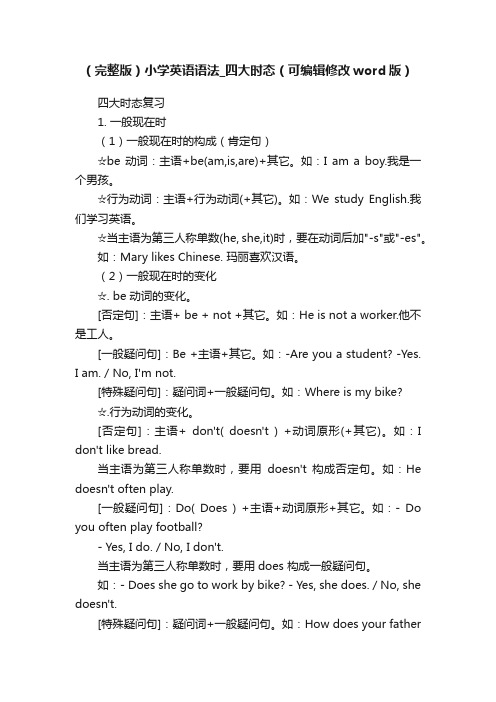
(完整版)小学英语语法_四大时态(可编辑修改word版)四大时态复习1. 一般现在时(1)一般现在时的构成(肯定句)☆be 动词:主语+be(am,is,are)+其它。
如:I am a boy.我是一个男孩。
☆行为动词:主语+行为动词(+其它)。
如:We study English.我们学习英语。
☆当主语为第三人称单数(he, she,it)时,要在动词后加"-s"或"-es"。
如:Mary likes Chinese. 玛丽喜欢汉语。
(2)一般现在时的变化☆. be 动词的变化。
[否定句]:主语+ be + not +其它。
如:He is not a worker.他不是工人。
[一般疑问句]:Be +主语+其它。
如:-Are you a student? -Yes.I am. / No, I'm not.[特殊疑问句]:疑问词+一般疑问句。
如:Where is my bike?☆.行为动词的变化。
[否定句]:主语+ don't( doesn't ) +动词原形(+其它)。
如:I don't like bread.当主语为第三人称单数时,要用doesn't 构成否定句。
如:He doesn't often play.[一般疑问句]:Do( Does ) +主语+动词原形+其它。
如:- Do you often play football?- Yes, I do. / No, I don't.当主语为第三人称单数时,要用does 构成一般疑问句。
如:- Does she go to work by bike? - Yes, she does. / No, she doesn't.[特殊疑问句]:疑问词+一般疑问句。
如:How does your fathergo to work?*动词+s 的变化规则1.一般情况下,直接加-s,如:cook-cooks, milk-milks2.以s. x. sh. ch. o 结尾,加-es,如:guess-guesses, wash-washes, watch-watches, go-goes3.以“辅音字母+y”结尾,变y 为i, 再加-es,如:study-studies2. 现在进行时(1)一般现在时的构成:be(am,is, are)+ 动词的ing 形式。
小学英语时态总结
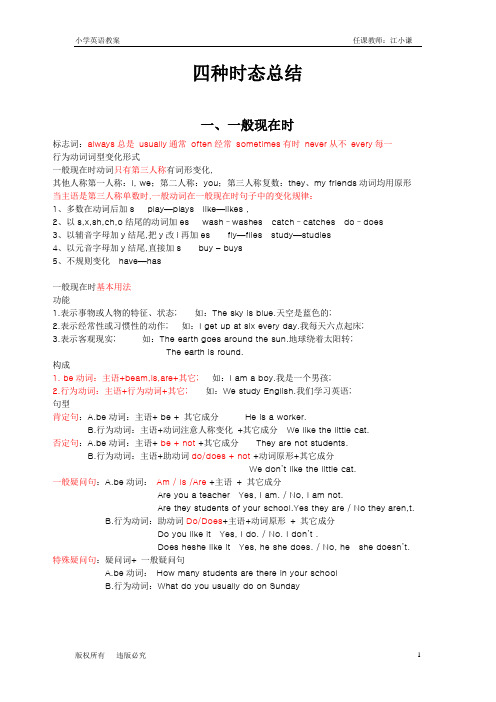
四种时态总结一、一般现在时标志词:always总是usually通常often经常sometimes有时never从不every每一行为动词词型变化形式一般现在时动词只有第三人称有词形变化,其他人称第一人称:I, we;第二人称:you;第三人称复数:they、my friends动词均用原形当主语是第三人称单数时,一般动词在一般现在时句子中的变化规律:1、多数在动词后加s play—plays like—likes ,2、以s,x,sh,ch,o结尾的动词加es wash–washes catch–catches do–does3、以辅音字母加y结尾,把y改i再加es fly—flies study—studies4、以元音字母加y结尾,直接加s buy – buys5、不规则变化have—has一般现在时基本用法功能1.表示事物或人物的特征、状态; 如:The sky is blue.天空是蓝色的;2.表示经常性或习惯性的动作; 如:I get up at six every day.我每天六点起床;3.表示客观现实; 如:The earth goes around the sun.地球绕着太阳转;The earth is round.构成1. be动词:主语+beam,is,are+其它;如:I am a boy.我是一个男孩;2.行为动词:主语+行为动词+其它;如:We study English.我们学习英语;句型肯定句:A.be动词:主语+ be + 其它成分He is a worker.B.行为动词:主语+动词注意人称变化+其它成分We like the little cat.否定句:A.be动词:主语+ be + not +其它成分They are not students.B.行为动词:主语+助动词do/does + not +动词原形+其它成分We don’t like the little cat.一般疑问句:A.be动词:Am / Is /Are +主语+ 其它成分Are you a teacher Yes, I am. / No, I am not.Are they students of your school.Yes they are / No they aren,t.B.行为动词:助动词Do/Does+主语+动词原形+ 其它成分Do you like it Yes, I do. / No. I don’t .Does heshe like it Yes, he she does. / No, he she doesn’t.特殊疑问句:疑问词+ 一般疑问句A.be动词:How many students are there in your schoolB.行为动词:What do you usually do on Sunday一般现在时动词be和have的变化形式1.动词Be 叫连系动词, 用法:第一人称单数用am,第三人称单数用is,其它人称用are;2.动词have的用法:第三人称单数用has以外,其它人称一律用have;如:注意事项 1.在英国,人们常用have got代替have,特别在疑问句和否定句中;2.当have如果不表示“有”时,构成疑问或否定句时,就借助于助动词do, does如:I have a new pen . 否:I have not a new pen. 表示有I have lunch at 12 o’clock. 否:I don’t have lunch at 12 o’clock. 表示吃二.现在进行时:标志词:now, look, listen,It’s+时间.现在进行时: 表示正在进行的、发生的动作基本结构:ambe is + 动词ingare肯定句:主语+ be动词am, are, is+ 现在分词ing+ 其他I am watching TV.否定句:主语+ be动词+ not + 现在分词ing+ 其他I am not watching TV.一般疑问句:Be动词Am, Are, Is + 主语+ 现在分词ing+ 其他Are you watching TV Yes, I am. / No, I am not.特殊疑问句:疑问词+ 一般疑问句What are you doing动词的-ing形式的变化规律:1. 直接加-ing watch—watching clean—cleaning2. 以-y结尾的动词,直接加-ing study—studying play—playing3. 以不发音的-e结尾的动词,先去-e再加-ing make—making come—coming4. 末尾只有一个元音字母和一个辅音字母的重读闭音节动词,双写末尾字母,再加-ing cut—cutting三、一般将来时的用法:表示将来某一时刻的动作或状态,或将来某一段时间内经常的动作或状态;标志词:tomorrow明天,the day after tomorrow后天,next 下一个,from now on从现在开始,in the future将来,soon不久等结构:1 beam,is ,are +going to+动词原形 2 will+动词原形“be going to+动词原形打算…”=”will+动词原形将,会…”I’m going to study tomorrow. I will study tomorrow.be going to着重于事先考虑好will 未事先考虑好----一般不用考虑肯定句:主语+ be am, are, is going to + 动词原形.主语+ will + 动词原形否定句:主语+ be am, are, is not going to + 动词原形.主语+won’t + 动词原形.一般疑问句:Be Am, Are, Is + 主语+ going to + 动词原形Will + 主语+ 动词原形特殊疑问句:疑问词+ 一般疑问句注意:will 常简略为'll,并与主语连写在一起,如:I'll,he'll,it'll,we'll,you'll,they'll;四、一般过去时标志词:yesterday昨天, last 上一个, this morning今天早上,ago以前,before 在…之前, in 2002在2002年等用法:表示过去某个时间发生的动作或存在的状态,常和表示过去的时间状语连用;也表示过去经常或反复发生的动作动词过去式变化规则:1.一般在动词末尾加-ed 如:watch-watched, cook-cooked2.结尾是e加d 如:taste-tasted3.末尾只有一个元音字母和一个辅音字母的重读闭音节,应双写末尾的辅音字母,再加-ed,如:stop-stopped4.以“辅音字母+y”结尾的,变y为i, 再加-ed,如:study-studied5.不规则动词过去式:am,is-was, are-were, do-did, see-saw, say-said, give-gave…句型:1、Be动词在一般过去时中的变化:⑴am 和is 变为was; 否定was not=wasn’t⑵are变为were; 否定were not=weren’t否定句:在was或were后加not一般疑问句:把was或were调到句首;2、行为动词在一般过去时中的变化否定句:didn’t + 动词原形如:Jim didn’t go home yesterday.一般疑问句:在句首加Did,句子中的动词过去式变回原形如:Did Jim go home yesterday 特殊疑问句:1疑问词+did+主语+动词原形如: What did Jim do yesterday2疑问词当主语时:疑问词+动词过去式如:Who went to home yesterday附录:小学常用不规则动词过去式一、不规则动词的过去式的构成1.把动词原形中的i改为a,变成过去式;如:begin—began,drink—drank,give—gave,ring—rang,sing—sang,sit—sat,s wim—swam2.把重读开音节中的i改为o,变成过去式;如:drive—drove,ride—rode,write—wrote3.改动词原形中的aw /ow为ew,变成过去式;如:draw—drew,grow—grew,know—knew,throw—threw动词show除外,show—showed4.动词原形中的e改为o,变成过去式;如:get—got,forget—forgot5.动词原形中的ee改为e,变成过去式;如:feed—fed,meet—met6.动词原形中的eep改为ept,变成过去式;如:keep—kept,sleep—slept,sweep—swept7.动词原形中的eak改为oke,变成过去式;如:break—broke,speak—spoke8.动词原形中的ell改为old,变成过去式;如:sell—sold,tell—told9.动词原形中的an改为oo,变成过去式;如:stand—stood,understand—understood10.以ought和aught结尾,且读音是〔 :t〕的过去式;如:bring—brought,buy—bought,think—thought,catch—caught,teach—taught11.以ould结尾且读音为〔ud〕的情态动词过去式;如:can—could,shall—should,will—would12.把动词原形中的o改为a,变成过去式;如:come—came,become—became13.在动词原形后加d或t变成过去式,并且发生音变;如:hear〔hi 〕—heard〔h :d〕, say〔sei〕—said〔sed〕,mean〔mi:n〕—meant 〔ment〕14.动词的过去式与动词原形一样;如:let—let,must—must,put—put,read—read〔red〕二.不规则动词表原形过去式中文释义am was 是表示存在、状态等are were 是表示存在、状态等become became 成为;变成begin began 开始break broke 打破bring brought 拿来;取来;带来build built 构筑;建造;建筑buy bought 购买;买can could 可以;能;可能;会catch caught 赶上车船等;捕获come came 来;来到cut cut 切;割;削;剪do/does did 做;干;行动draw drew 画drink drank 喝;饮drive drove 开车;驾驶eat ate 吃feel felt 感到;觉得find found 寻找;查找fly flew 飞行forget forgot 忘记;忘却get got 变得give gave 给;授予go went 去have/has had 得病;患病;有;吃;饮hear heard 听见;听说hide hid 隐藏is was 是表示存在、状态等keep kept 保持;使保持某种状态know knew 知道;了解leave left 离去;出发let let 允许;让lose lost 失去;丧失make made 使;促使;迫使;做;制作may might 可能;可以mean meant 表示……的意思;作……的解释meet met 遇见;相逢put put 放;摆;装read read /e/ 读;阅读ride rode 骑ring rang 铃响rise rose 上升run ran 跑;奔跑say said 说;讲see saw 看见send sent 发送;寄;派;遣set set 放, 置show showed 出示;给……看shut shut 关上门、盖、窗户等sing sang 唱;唱歌sit sat 坐sleep slept 睡;睡觉speak spoke 说;说话swim swam 游泳take took 搭乘;花费时间;拿走;带到teach taught 教;讲授tell told 告诉;讲述think thought 想;思考will would 将要win won 赢;获胜write wrote 书写小学英语语法词性总结一、形容词、副词的比较级和最高级的用法:当两种物体之间相互比较时,我们要用形容词或副词的比较级;当相互比较的物体是三个或三个以上时,用形容词或副词的最高级;比较级二者比较,标志词:than最高级三者以上比较,标志词:the形容词、副词的比较级和最高级的变化规律:1. 单音节形容词或副词后面直接加-er或-est tall—taller—tallest fast—faster—fastest2. 以-e结尾的单音节形容词或副词直接加-r或-st large—larger—largest nice—nicer—nicest3. 以-y结尾的形容词或副词,改-y为-i再加-er或-estbusy—busier—busiest early—earlier—earliest4. 形容词或副词是重读闭音节时,双写最后的辅音字母,再加-er或-est hot—hotter—hottest5. 多音节形容词或副词前面直接加more或most beautiful—more beautiful—most beautiful6. 以ly结尾的副词一般加more或most slowly—more slowly—most slowly7. 不规则变化good well- better-best bad badly-worse-worst little-less-leastfar-farther-further manymuch- more – most形容词、副词的比较级和最高级用法:比较级:1、形容词:物体A + am / are / is + 形容词比较级+ than + 物体BI am taller than you. This picture is more beautiful than that one.2、副词:物体A + 行为动词+ 副词比较级+ than + 物体B.He studies better than me.最高级:1、形容词:物体A + am / are / is + the + 形容词最高级+ 比较范围of + 人/物,in + 地方.I am the tallest in the class. Shanghai is one of the biggest cities in China.2、副词:物体A + 行为动词+ 副词最高级+ 比较范围of + 人/物,in + 地方.Cheetahs run fastest in the world. He studies best of us.表示两者对比相同:主语+谓语+as+形容词/副词原形+as+从句This box is as big as mine. This coat is not so/as cheap as that one.I study English as hard as my brother.英语比较级和最高级练习一1.A pig is __ than a dog.A. much heavyB. more heavierC much heavier D. more heavy2.--Which is __ season in Beijing--I think it’s spring.A. goodB. wellC. bestD. the best3. The city is becoming ______.A. more beautiful and moreB. more beautiful and beautifulC. more and more beautifulD. more beautiful and beautifuler4.Which does Alice like _____ , Chinese or ArtA. wellB. bestC. betterD. much5.The Changjiang River is one of ____ in the world.A. the longest riverB. longest riversC. the longest riversD. longer rivers6.LiMing speaks Chinese _____ better than me.A. veryB. moreC. a lot ofD. much7.There are____boys in Class Two than in Class Four.A. moreB. manyC. mostD. best8.Who has _____ oranges now, Jim, Lily or LucyA. muchB. biggestC. betterD. the most9.Mother is _____ in my family.A. busyB. busierC. the busiestD. more10.No one is _____ Lucy in the class.A. so tallest asB. as taller asC. so high asD. as tall as二写出下列形容词与副词的比较级与最高级形式:long_____ ______ wide ______ _______ fat ____ _____heavy____ ______ slow ______ _______ few____ _____brightly______ -_____ bably _____ _______ far____ _____quickly _____ ______ happy_____ -______ unhappy________三用所给词的正确形式填空:1. Of the two girls, I find Lucy the _______ clever.2. Gold黄金is ______ little useful than iron铁.3. My sister is two years _______ old than I.4. John’s parents have four daughters, and she is the _____ young child.5. The _____ cheap bags are the not usually the best ones.6. The short one is by far _______ expensive of the five.7. The boy is not so ______ interesting as his brother.8. Dick sings _____ well, she sings ______well than John, but Mary sings______wellin her class.9. She will be much ______ happy in her mew house.10. This dress is ______ that.twice, as…as…, expensive参考答案:一C D C C C D A D C D二longer longest wider widestfatter fattest heavier heaviestslower slowest fewer fewestmore brightly, most brightly worse, worstfurther,furthest more quickly, most quicklyhappier happiest unhappier unhappiest三clever lessOlder youngestCheapest the mostInteresting well, better, the bestHappier twice as expensive as二、情态动词情态动词的定义:情态动词有词义,但它不能单独作谓语,它必须和其他动词一起构成谓语;情态动词没有人称和数的变化,后加动词原形;can 能够,会may 可以shall 将,要should 应该must 必须havehasto 不得不had better 最好情态动词的用法:情态动词肯定句否定句can 主语+ can + 动词原形主语+ can + not + 动词原形may 主语+ may + 动词原形主语+ may + not + 动词原形shall 主语+ shall + 动词原形主语+ shall + not + 动词原形should 主语+ should + 动词原形主语+ should + not + 动词原形must 主语+ must + 动词原形主语+ must + not + 动词原形havehasto 主语+ havehasto + 动词原形主语+ don’tdoesn’t+havehasto + 动词原形had better 主语+ had better + 动词原形主语+ had better + not + 动词原形情态动词疑问句肯定回答否定回答can Can + 主语+动词原形Yes, ~can. No, ~can’t.may May + 主语+动词原形Yes, ~may. / Sure. No, ~may not.shall Shall + 主语+动词原形Yes, please. / All right. No, le t’s not.should Should +主语+动词原形Yes, ~should. No, ~shouldn’t.must Must + 主语+动词原形Yes, ~must. No, ~needn’t.havehasto Do does+主语+Yes, ~do does. No, ~don’t doesn’t.have to +动词原形had better ///三、名词复数规则1.一般情况下,直接加-s,如:book-books, bag-bags, cat-cats, bed-beds2.以s. x. sh. ch结尾,加-es,如:bus-buses, box-boxes, brush-brushes, watch-watches 3.以“辅音字母+y”结尾,变y为i, 再加-es,如:family-families, strawberry-strawberries4.以“f或fe”结尾,变f或fe为v, 再加-es,如:knife-knives5.不规则名词复数:man-men, woman-women, policeman-policemen,policewoman-policewomen, mouse-mice, child-children,foot-feet,tooth-teeth,fish-fish, people-people, Chinese-Chinese, Japanese-Japanese改fe为ve加s口诀1树叶半数自己黄妻子拿刀去割粮架后窜出一只狼就像小偷逃命忙2常用不规则名词复数形式foot-feet 脚man-men 男人woman-women 女人tooth-teeth 牙mouse-mice 老鼠goose-geese 鹅child-children 小孩3单复数同形fish 鱼li 里jin 斤yuan 元mu 亩sheep 羊deer 小鹿Chinese 中国人Japanese 日本人means 手段单复名词同形:中国人日本人都爱绵羊鹿和鱼.高频考点man woman 作定词修饰复数时需变为复数形式two men doctors 两位男医生many women leaders 很多女领导4只有复数形式,没有单数形式trousers 裤子clothes 衣服shorts 短裤goods 商品glasses 眼镜shoes 鞋5常用不可数名词advice 建议baggage 行李bread 面包rain 雨steel 钢gold 金sand 沙grass 草glass 玻璃oil 油paper 纸butter 黄油salt 盐beauty 漂亮change 零钱information 信息smoke water 水homework 作业cloth 布food 食品money 钱tea 茶snow 雪wealth 财富furniture 家具cotton 棉花rice 大米fruit 水果milk 牛奶四、介词口诀:介词的用法早、午、晚要用in,at黎明、午夜、点与分;年、月、年月、季节、周,阳光、灯、影、衣、冒in;将来时态in...以后,小处at大处in;有形with无形by,语言、单位、材料in;特征、方面与方式,心情成语惯用in;介词at和to表方向,攻击、位置、恶、善分;日子、日期、年月日,星期加上早、午、晚,收音、农场、值日on,关于、基础、靠、著论;着、罢、出售、偷、公、假,故意、支付、相反,准;特定时日和“一……就”,on后常接动名词;年、月、日加早、午、晚,of之前on代in;步行、驴、马、玩笑on,cab,carriage则用in;at山脚、门口、在当前,速、温、日落、价、核心;工具、和、同随with,具有、独立、就、原因;就……来说宾译主,对、有、方状、表细分;海、陆、空、车、偶、被by,单数、人类know to man;this、that、tomorrow,yesterday,next、last、one;接年、月、季、星期、周,介词省略已习惯;over、under正上下,above、below则不然,若与数量词连用,混合使用亦无关;‘beyond超出、无、不能,against靠着,对与反;besides,except分内外,among之内along沿;同类比较except,加for异类记心间;原状because of,、owing to、due to表语形容词under后接修、建中,of、from物、化分;before、after表一点, ago、later表一段;before能接完成时,ago过去极有限;since以来during间,since时态多变换;与之相比beside,除了last but one;复不定for、找、价、原,对、给、段、去、为、作、赞;快到、对、向t owards,工、学、军、城、北、上、南;but for否定用虚拟,复合介词待后言;ing型由于鉴,除了除外与包合;之后、关于、在......方面,有关介词须记全;in内to外表位置,山、水、国界to在前;五、代词的用法.形容词性物主代词my your his her its our their 名词性物主代词mine yours his hers its ours theirs反身代词myselfyourself/yourselveshimself herself itself ourselves themselves主格:一般放在句子前,做主语.宾格:一般放在动词,介词for、to、of…后.形容词性物主代词:修饰名词,放在名词前.名词性物主代词:代表名词,后不跟名词.反身代词及其一般用法反身代词表示动作回到其执行者本身用以加强语气;反身代词的分类1.第一人称单数:myself 我自己复数:ourselves 我们自己2.第二人称单数:yourself 你自己复数:yourselves 你们自己3.第三人称单数:himself 他自己herself 她自己itself 它自己复数:themselves 他们自己、她们自己、它们自己反身代词在句子中的用法1.作表语She's not herself today. 她今天跟平常真是判若两人;2.作宾语Please help yourself to some fish. 请随便吃点鱼;3.作介宾I learned English by myself. 我自学英语;4.作同位语He can do that himself. 他自己能做那件事;There be 有,表示存在;There is+单数、不可数名词There are+复数“There be” 句型结构:肯定句:“ There be+ 主语某人/ 某物+ 某地There isa boy in the room.否定句:“There be + not any+ 主语+ 某地There aren't any books on the desk. 一般疑问句:“Be is、are there +any+ 主语+ 某地“Yes , there is / are.” “No, there isn't / aren't. ”It +be谈论天气“ It's going to rain.”说到时间“It's time to go to school.”距离远近“It's far to get there.”情况程度“It's hard to learn.”六、连词的用法一、并列连词:1. and 连接单词My brother and I study in the same school.连接短语Our knowledge may come from the books and from practice.连接句子We are singing and they are dancing.2. but 但是/而是I have a pen but no pencil.or 或者Will you go there by bus or on foot3.nothing but 除了,只有I did nothing but watch it.4.or表示否则Hurry up or you will be late.5.for 表示因为He is good at math for he studies harder than others.6.still 表示后句概念由前句转折而来The weather is very cold, still we needn’t wear more clothes.7.not only…but also 不仅…而且可并列主、谓、宾、表及句子主语并列时,谓语要就近一致Not only he but also I am a teacher.8.as well as 以及,同样并列单词、短语、句子;并列主语时,动词要随前面的主语变化He works as well as he can9.either…or 既…又…,或…或…并列主、谓、宾、表及状语Either come in or go out.10.neither…nor 既不…也不并列主、谓、宾、表、状语,并列主语时,谓语就近一致Neither you nor he speaks French.12.both…and 和,既…也并列主、谓、宾及表语I can play both football and basketball.13.nor 也不,引导句子要倒装He can not speak English, nor can I.You like apples, so do I.二、从属连词:1. after 表示“时间”,在…之后After I finished the school, I became a worker in the factory.2.although/though 表示让步, “尽管”Although she is young, she knows a lot.3.as 表示时间,“当…时”,方式“象…”,原因,“由于、因为”让步,“尽管、虽然”As it was late, we must go now.4.as if/as though 表方式,“似乎、好像”He told is such a story as though he had been there before.5.as long as/so long as 表条件,“只要”As long as I am free, I’ll go to help you.6.as soon as 表时间,“一…就…”I will phone you as soon as I come back.7.because 表原因,“因为”I have to stay in bed because I am ill.8.before 表时间,“在…之前“You should think more before you do it.9.even if/ even though 表让步,“即使”You should try again even if you failed.10.hardly…when 表时间,“刚一…就”Hardly I entered the gate when the bell rang.11.if “假如”,引导条件状语从句What should I do net if the rain doesn’t stop“是否”,引导宾语从句I don’t know if he comes back or not.12.In case 表目的,“以防,以免”You should be more careful in case there is a fire.13.In order that 表目的,“为了,以便”We study hard in order that we can pass the exam.14.no matter +疑问词表让步,“无论,不管”No matter what you do, you should try your best.15.no sooner…than 表时间,“刚一…就…”No sooner had I come home than it began to rain.16.now that 表原因,“既然,因为,由于”Now that you are on duty,you should clean the classroom. 17.once 表时间,“一旦…”Once you promise , you should do it.三、其他1.since 表时间,“自从…以来”He has been in this company since he left school.表原因,“既然,由于”Since the job is dangerous, let’s do it more carefully.2.so far as/as far as 表条件,“就…而言,就…而论”As far as I know, it is easy for you to speak in English.3.so that 表目的“以便”Speak loud so that everybody can hear clearly.表结果“如此,以致”He got up so late that he missed the bus.4.than 表示比较,“比”Things were worse than we thought.5.that 无词义,引导名词性从句It is dangerous that we walk on the thin ice.引导定语从句和状语从句She hurried that she might not be late for work.6.unless 表条件,“除非,如果不”I will go to the zoo unless it rains.7.Until/till 表时间,“直到…为止”I’ll wait till he comes back.8.when 表时间,“当…时“When they got there, the train has left.9.whether “是否”引导名词性从句Whether he can some to see us is unknown.表让步,“不管/无论、是否”Whether she is ill or well, she is always happy.10.while 表时间,“当…时”While he was in Beijing, he visited the Great Wall.表让步,“尽管,既然”While I find the problems very difficult, I don’t think them insoluble.11.whenever 表时间,“无论什么时候”Whenever you meet any trouble, tell me at once.。
28小学英语语法:小学英语八大时态复习(100张幻灯片)

carryies do es wash es visit s exercise s enjoy s jump s hhaavse
一般现在时否定式
be + not don’t do / doesn’t do
II 一般现在时的否定式
1.Be 动词的否定式: be + not
I am a teacher.
Exercise: 1. —What are you going to do this
afternoon? —I am going to the cinema with some
I often go there. You like the music. He goes to work by bus . We /You/They like it.
Do you often go there ? Do you like the music.? Does he go to work by bus ? Do you/they like it?
把句子中的动词改为过去式形式。通常有 五种写法。
动词过去式的写法:
一般情况,
I work in this city.
在动词末尾
I worked in this city last year. 加ed
They live in Shanghai . They lived in Shanghai last year.
先变y 为i,再加es
·特殊 have-has 等
写出下列动词的第三人称单数形式
help s guess es flyies makes leaves fix es swim s know s
play s
closes
完整版)小学英语四大时态总结图
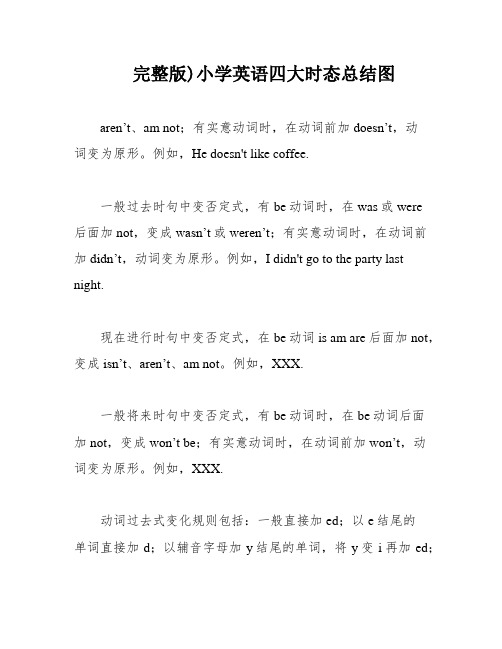
完整版)小学英语四大时态总结图aren’t、am not;有实意动词时,在动词前加doesn’t,动词变为原形。
例如,He doesn't like coffee.一般过去时句中变否定式,有be动词时,在was或were后面加not,变成wasn’t或weren’t;有实意动词时,在动词前加didn’t,动词变为原形。
例如,I didn't go to the party last night.现在进行时句中变否定式,在be动词is am are后面加not,变成isn’t、aren’t、am not。
例如,XXX.一般将来时句中变否定式,有be动词时,在be动词后面加not,变成won’t be;有实意动词时,在动词前加won’t,动词变为原形。
例如,XXX.动词过去式变化规则包括:一般直接加ed;以e结尾的单词直接加d;以辅音字母加y结尾的单词,将y变i再加ed;以辅元辅结尾的单词,双写最后一个辅音字母加ed;不规则变化。
例如,XXX.表示过去时间的词汇包括:yesterday、the day before yesterday、last + 时间(例如last year)、时间段+ago(例如one year ago)、in + 表示过去时间的词汇(例如in 1996)。
表示将来时间的词汇包括:now、tomorrow、the day after tomorrow、next + 时间段(例如next month)、in + 表示将来时间的词汇。
例如,We will go to the beach XXX.回答否定句时,需要注意人称及代词方面的变化。
有be 动词的句子中,将be动词提前,回答时用be动词回答;有实意动词时,需要助动词did的帮助,将did提前,回答时用did 回答。
最后,需要注意语态的变化。
例如,Active Voice句子:She ate the pizza。
(完整版)小学最全英语语法汇总
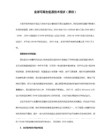
10 页 共 26 页 What (问什么事,什么物或什么工作) What are you doing? I’m reading. What is that? It’s a book. What is she?(What’s her job?) She’s a nurse. What colour(问颜色) What colour is your coat? It’s red. What time(时间) What time is it? What’s the time? It’s seven. when (什么时候) When do you get up? I get up at six thirty. When is your birthday? It’s on the 21st of December. Which(哪一个) Which is your watch, the yellow one or the white one? The yellow is mine. Who(谁) Who is the man with a big nose? He’s my uncle. Whose(谁的) Whose bag is it? Whose is this bag? It’s his bag.
2 页 共 26 页 4. 特殊的 do-does ,have-has, go-goes 2.现在进行时, (1)表示正在发生的动作,通常用“now现在, look看,linsen听”. (2)基本形式: be + 动词ing eg: I am(not) doing my homework. You/We/They are(not) reading. He/She/It is(not) eating. What are you doing? Is he reading? (3)动词的现在分词形式(动词+ing) 一般情况 +ing walk—walking 结尾是不发音的 e -e + ing come—coming 重读闭音节 双写最后一个字母+ing run-running swim-swimming 3. 一般过去时 (1) 表示过去已经发生的事情,通常用 “last …上一个…, just now刚才, a moment ago刚才,
六年级英语【八大时态标志词】单词汇总
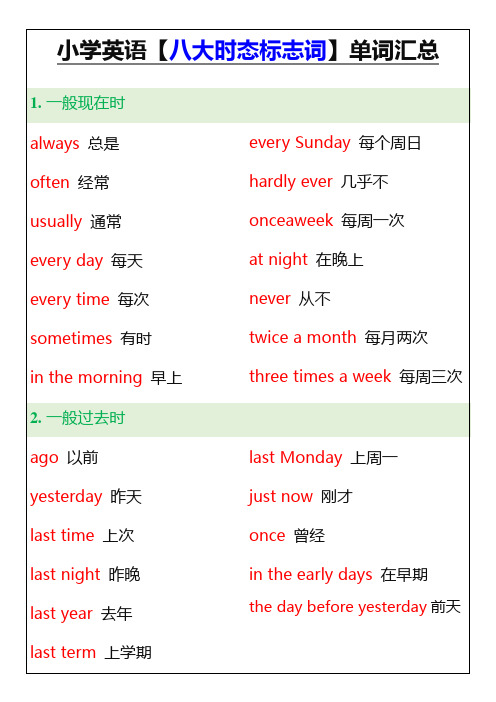
already已经
yet还
just刚才
never从不
ever曾经
before以前
uptonow目前为止
sofห้องสมุดไป่ตู้r目前为止
recently最近
since+过去某一时间
twice两次
tillnow迄今为止
uptonow到目前为止
5.现在进行时
now现在
look看
listen听
atthistime此时
twiceamonth每月两次
threetimesaweek每周三次
2.一般过去时
ago以前
yesterday昨天
lasttime上次
lastnight昨晚
lastyear去年
lastterm上学期
lastMonday上周一
justnow刚才
once曾经
intheearlydays在早期
thedaybeforeyesterday前天
(2)before+过去时间点before8:00
(3)upuntil+过去时间点upuntilthen直到那时
6.过去进行时
atthattime在那时
atthatmoment在那时
thewholemorning整个早上
7.将来进行时
tomorrow明天
soon不久
nextweek下周
thedayaftertomorrow后天
8.过去完成时
(1)by+过去时间点bythetime到..时候为止
bythen到那时候bylasttime最后一次
3.一般将来时
tomorrow明天
英语所有语法知识点六年级

英语所有语法知识点六年级一、动词时态1. 一般现在时:用于表示经常性或普遍性的动作、情况或状态例句:I play football every Sunday.2. 一般过去时:用于表示过去某个时间发生的动作或状态例句:She watched a movie yesterday.3. 一般将来时:用于表示将来要发生的动作或情况例句:I will visit my grandparents next week.4. 进行时态:用于表示正在进行的动作例句:They are eating lunch now.5. 完成时态:用于表示已经完成的动作或状态例句:He has finished his homework.二、名词1. 可数名词与不可数名词例句:There are three apples on the table. (可数名词) I want some water. (不可数名词)2. 单数名词与复数名词例句:The dog is cute. (单数名词)The dogs are playing in the park. (复数名词)3. 名词所有格例句:Tom's book is on the table.三、形容词与副词1. 形容词用于修饰名词,表示名词的性质、特征或状态例句:She has a beautiful flower.2. 副词用于修饰动词、形容词或副词,表示方式、程度或时间等例句:He runs quickly.四、冠词1. 不定冠词(a/an)用于泛指单数可数名词前例句:I see an apple.2. 定冠词(the)用于特指或泛指某个人或物例句:The cat is on the table.五、代词1. 主格代词用于作主语例句:She is my friend.2. 宾格代词用于作宾语例句:He gave me a present.3. 物主代词表示所属关系例句:This is his book.六、介词1. 介词用于表示位置、时间、原因、方式等例句:He is in the park.2. 一些常见介词:in, on, at, with, for, to 等七、连词1. 并列连词用于连接同等重要的词、短语、句子等例句:I like apples and oranges.2. 从属连词用于引导从句例句:She is happy because she won the game.八、疑问词1. 疑问词用于构成疑问句例句:Where is the book?九、形容词比较级与最高级1. 形容词比较级用于表示两者之间的比较例句:She is taller than her sister.2. 形容词最高级用于表示三者或三者以上的比较例句:She is the tallest girl in the class.十、情态动词1. 情态动词用于表示能力、可能性、许可等例句:I can swim.十一、直接引语与间接引语1. 直接引语直接引述别人的原话例句:He said, "I am happy."2. 间接引语是对别人的话进行转述例句:He said he was happy.以上是六年级英语的所有语法知识点,掌握这些知识将会帮助你更好地理解和运用英语语法。
小学英语时态-PPT
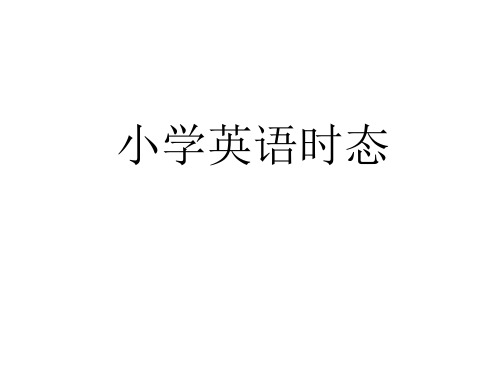
一般现在时
(2) 当句子中即没有be动词,也没有情态动词时 ①陈述句:We get up at 7:00 every morning. 疑问句→Do you get up at 7:00 every morning? 否定句→We don’t get up at 7:00 every morning. ②陈述句:She has a little brother. 疑问句→ Does she have a little brother? 否定句→ She doesn’t have a little brother.
现在进行时
1. The boy is playing basketball. 否定句:____________________________ 一般疑问句:_________________________ 肯定回答:__________________________ 否定回答:__________________________
12. We _________ (not watch) TV on Monday.
13. Nick_______ (not go) to the zoo on Sunday.
14. They _________ (like) the World Cup?
按要求完成句子
1.Do you often play football after school? (肯 定回答) 2. I have many books. (改为否定句) 3. Gao Shan’s sister likes playing table tennis (改为否定句) 4. She lives in a small town near New York. (改为一般疑问句) 5. I watch TV every day. (改为一般疑问句) 6. David has got a goal. (改为一般疑问句)
小学英语语法大全(四至六年级)

小学英语语法大全(四至六年级)小学英语语法大全(四至六年级)第一章:基本语法概念1.1 名词定义:名词是表示人、事物、地点或抽象概念的词。
名词是表示人、事物、地点或抽象概念的词。
分类:- 人物名词:boy, girl, teacher, doctor- 地点名词:home, school, park, city- 抽象名词:love, happiness, health, education1.2 冠词定义:冠词是用来修饰名词的词。
冠词是用来修饰名词的词。
分类:- 不定冠词:a, an- 定冠词:the1.3 代词定义:代词是用来代替名词的词。
代词是用来代替名词的词。
分类:- 人称代词:I, you, he, she, it, we, they- 物主代词:my, your, his, her, its, our, their- 反身代词:myself, yourself, himself等1.4 形容词和副词定义:- 形容词:用来修饰名词的词。
- 副词:用来修饰动词、形容词或其他副词的词。
比较级和最高级:- 比较级:表示两个事物之间的比较。
如:bigger, smaller- 最高级:表示多个事物中的最高或最低。
如:biggest, smallest 第二章:动词2.1 动词的分类- 行为动词:run, jump, read, write- 状态动词:be, have, exist- 助动词:do, does, did, can, may, shall, will2.2 动词的时态- 现在时:表示现在或经常发生的事。
如:I read a book.- 过去时:表示过去发生的事。
如:I read a book yesterday.- 将来时:表示将来会发生的的事。
如:I will read a book tomorrow.第三章:句子结构3.1 简单句简单句是由一个主语和一个谓语构成的句子。
如:The cat sleeps.3.2 复合句复合句是由两个或两个以上的简单句合并而成的句子。
小学英语四种时态
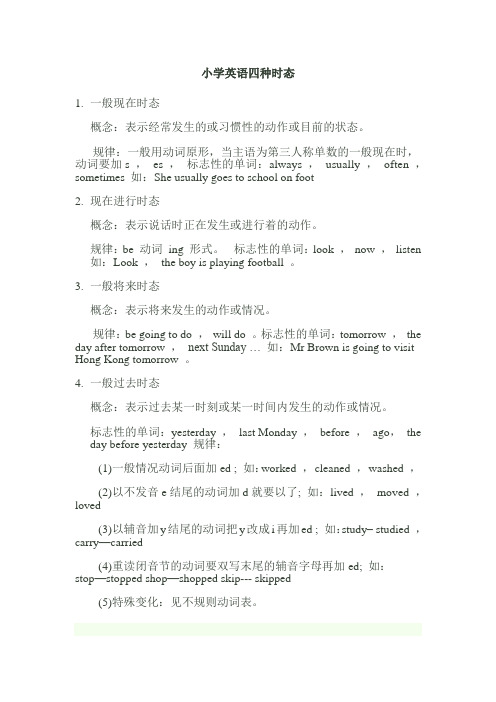
小学英语四种时态1.一般现在时态概念:表示经常发生的或习惯性的动作或目前的状态。
规律:一般用动词原形,当主语为第三人称单数的一般现在时,动词要加s ,es ,标志性的单词:always ,usually ,often ,sometimes 如:She usually goes to school on foot2.现在进行时态概念:表示说话时正在发生或进行着的动作。
规律:be 动词ing 形式。
标志性的单词:look ,now ,listen 如:Look ,the boy is playing football 。
3.一般将来时态概念:表示将来发生的动作或情况。
规律:be going to do ,will do 。
标志性的单词:tomorrow ,the day after tomorrow ,next Sunday … 如:Mr Brown is going to visit Hong Kong tomorrow 。
4.一般过去时态概念:表示过去某一时刻或某一时间内发生的动作或情况。
标志性的单词:yesterday ,last Monday ,before ,ago,the day before yesterday 规律:(1)一般情况动词后面加ed ; 如:worked ,cleaned ,washed ,(2)以不发音e结尾的动词加d就要以了; 如:lived ,moved ,loved(3)以辅音加y结尾的动词把y改成i再加ed ; 如:study– studied ,carry—carried(4)重读闭音节的动词要双写末尾的辅音字母再加ed; 如:stop—stopped shop—shopped skip--- skipped(5)特殊变化:见不规则动词表。
小学英语固定搭配Good night 晚安.in the morning 在早上at noon 在中午in the afternoon 在下午in the evening 在傍晚at night 在夜间have/eat breakfast 吃早饭have/eat lunch 吃午饭have/eat supper(dinner) 吃晚饭read a book 读书sing a song 唱歌have a meeting 开会have class 上课have a party 聚会have a competition 竞赛have a sleep 睡觉have a snack 吃零食have a picnic 野餐have a buffet dinner 吃自助餐draw pictures 画画listen to music 听音乐listen to the radio 听收音机learn English 学习英语learn Chinese 学习语文Learn math 学习数学tell stories 讲故事take a walk 散步ask and answer questions 问答问题fly a kite 放风筝ride a bike 骑自行车ride a horse 骑马play computer games 玩电脑游戏play games 做游戏play hide and seek 玩捉迷藏do homework 做作业watch TV 看电视take a shower 洗淋浴take a bath 洗澡open the door 开门open the window 开窗户close the door 关门close the window 关窗户paly football 踢足球/打橄榄球play basketball 打篮球play volleyball 打排球play badminton 打羽毛球play golf 打高尔夫球play bowling 打保龄球play table tennis 打乒乓球play baseball 打棒球play tennis 打网球play soccer 踢足球play hockey 打曲棍球play chess 下棋go fishing 去钓鱼go swimming 去游泳go shopping 去购物go skating 去滑冰go bike-riding/ go cycling 去骑自行车go sking 去滑雪go camping 去野营listen to the news 听新闻read the newspaper 看报read the magazine 看杂志go to school 去上学go home 回家go to the park 去公园go to the zoo 去动物园go to the library 去图书馆go to the hospital 去医院go to the cinema 去电影院go to see a film /movie去看电影get up 起床go to bed 上床go to sleep 去睡觉brush the teeth 刷牙wash the hands 洗手wash the face 洗脸wash clothes 洗衣服air the room 给房间通风make the bed 铺床sweep the floor 扫地mop the floor 拖地clean the room 打扫房间climb the trees 爬树climb the mountains 爬山cook the meals 做饭drink milk/juice/coca cola 喝牛奶/果汁/可乐play the piano 弹钢琴play the violin 拉小提琴play the drum 打鼓play the guitar 弹吉他play the xylophone 弹木琴play the flute 吹笛子play the harp 弹竖琴play the erhu 拉二胡play the zither 弹古筝play the banjo 弹班卓play the trumpet 吹小号stay at home 呆在家里at home 在家at school 在学校at church 在教堂make a cake 做蛋糕take pictures/photos 照相comb hair 梳头发have a haircut 理发go away 走开at the weekend 在周末stand up 起立sit down 坐下New year 元旦Spring Festival 春节Lantern Festival 元宵节Spring Cleaning Day 清明节Dragon Boat Festival 龙舟节International labour day 国际劳动节Trees planting day 植树节Children's day 儿童节Party's day 党的生日Army's day 建军节Teacher's day 教师节National day 国庆节Thanksgiving day 感恩节Chrismas day 圣诞节in the morning 在早上at noon 在中午in the afternoon 在下午in the evening 在傍晚at night 在夜间have/eat breakfast 吃早饭have/eat lunch 吃午饭have/eat supper(dinner) 吃晚饭read a book 读书sing a song 唱歌have a meeting 开会have class 上课have a party 聚会have a competition 竞赛have a sleep 睡觉have a snack 吃零食have a picnic 野餐have a buffet dinner 吃自助餐draw pictures 画画listen to music 听音乐listen to the radio 听收音机learn English 学习英语learn Chinese 学习语文Learn math 学习数学tell stories 讲故事take a walk 散步ask and answer questions 问答问题fly a kite 放风筝ride a bike 骑自行车ride a horse 骑马play computer games 玩电脑游戏play games 做游戏play hide and seek 玩捉迷藏do homework 做作业watch TV 看电视take a shower 洗淋浴take a bath 洗澡open the door 开门open the window 开窗户close the door 关门close the window 关窗户paly football 踢足球/打橄榄球play basketball 打篮球play volleyball 打排球play badminton 打羽毛球play golf 打高尔夫球play bowling 打保龄球play table tennis 打乒乓球play baseball 打棒球play tennis 打网球play soccer 踢足球play hockey 打曲棍球play chess 下棋go fishing 去钓鱼go swimming 去游泳go shopping 去购物go skating 去滑冰go bike-riding/ go cycling 去骑自行车go sking 去滑雪go camping 去野营listen to the news 听新闻read the newspaper 看报read the magazine 看杂志go to school 去上学go home 回家go to the park 去公园go to the zoo 去动物园go to the library 去图书馆go to the hospital 去医院go to the cinema 去电影院go to see a film /movie去看电影get up 起床go to bed 上床go to sleep 去睡觉brush the teeth 刷牙wash the hands 洗手wash the face 洗脸wash clothes 洗衣服air the room 给房间通风make the bed 铺床sweep the floor 扫地mop the floor 拖地clean the room 打扫房间climb the trees 爬树climb the mountains 爬山cook the meals 做饭drink milk/juice/coca cola 喝牛奶/果汁/可乐play the piano 弹钢琴play the violin 拉小提琴play the drum 打鼓play the guitar 弹吉他play the xylophone 弹木琴play the flute 吹笛子play the harp 弹竖琴play the erhu 拉二胡play the zither 弹古筝play the banjo 弹班卓play the trumpet 吹小号stay at home 呆在家里at home 在家at school 在学校at church 在教堂make a cake 做蛋糕take pictures/photos 照相comb hair 梳头发have a haircut 理发go away 走开at the weekend 在周末stand up 起立sit down 坐下New year 元旦Spring Festival 春节Lantern Festival 元宵节Spring Cleaning Day 清明节Dragon Boat Festival 龙舟节International labour day 国际劳动节Trees planting day 植树节Children's day 儿童节Party's day 党的生日Army's day 建军节Teacher's day 教师节National day 国庆节小学英语动词过去式agree 同意agreedask 问askedanswer 回答answeredbecome 成为becamebegin 开始beganbring 带来broughtbuy 买boughtcall 呼叫calledcarry 搬运carriedcatch 抓住caughtcheck 检查checkedclean 清洁cleanedclimb 爬climbedcome 来camecook 煮cookedcut 切cutdance 跳舞danceddo 做diddraw 画drewdrink 喝drankdrive 驾驶droveeat 吃ateenjoy 欣赏enjoyedfeel 感觉feltfly 飞fliedforget 忘记forgotfish 钓鱼fishedget 得到gotgive 给gavego 去wentgrow 成长grewhave 有hadhear 听到heardhelp 帮助helpedjump 跳jumpedkeep 保存keptknow 知道knewlearn 学习learned listen 听listenedlike 喜欢likedlook 看lookedlive 生活livedlove 喜爱lovedmake 做mademeet 遇见metmove 移动moved need 需要needed open 打开opened paint 画paintedpick 摘pickedplay 玩playedplan 计划planned practise 练习practised prefer 更喜欢preferred put 放putread 读readride 骑roderun 跑ransay 说saidsee 看sawsit 坐satskip 跳skippedspeak 说spokestart 开始startedstay 停留stayed sweep 扫sweptstudy 学习studied swim 游泳swamtalk 谈话talkedtake 带去tookteach 教taughtthank 谢谢thanked tell 告诉toldthink 想thought travel 旅游traveledtry 试trieduse 使用used wake 醒来woke walk 走路walked want 想wanted wash 洗washed watch 看watched water 浇水watered wave 挥动waved work 工作worked worry 担心worried write 写wrote小学英语可数名词复数形式1)以y结尾的专有名词,或元音字母+y 结尾的名词变复数时,直接加s变复数。
小学的四大时态知识点总结
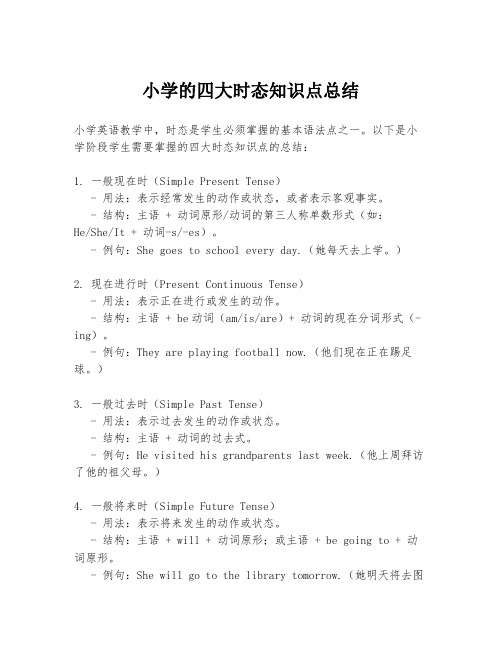
小学的四大时态知识点总结小学英语教学中,时态是学生必须掌握的基本语法点之一。
以下是小学阶段学生需要掌握的四大时态知识点的总结:1. 一般现在时(Simple Present Tense)- 用法:表示经常发生的动作或状态,或者表示客观事实。
- 结构:主语 + 动词原形/动词的第三人称单数形式(如:He/She/It + 动词-s/-es)。
- 例句:She goes to school every day.(她每天去上学。
)2. 现在进行时(Present Continuous Tense)- 用法:表示正在进行或发生的动作。
- 结构:主语 + be动词(am/is/are)+ 动词的现在分词形式(-ing)。
- 例句:They are playing football now.(他们现在正在踢足球。
)3. 一般过去时(Simple Past Tense)- 用法:表示过去发生的动作或状态。
- 结构:主语 + 动词的过去式。
- 例句:He visited his grandparents last week.(他上周拜访了他的祖父母。
)4. 一般将来时(Simple Future Tense)- 用法:表示将来发生的动作或状态。
- 结构:主语 + will + 动词原形;或主语 + be going to + 动词原形。
- 例句:She will go to the library tomorrow.(她明天将去图书馆。
)掌握这些基本时态对于小学生来说至关重要,它们是构建句子和表达思想的基础。
在学习过程中,学生应该通过大量的练习和实际应用来加深对这些时态的理解和运用。
同时,老师和家长也应该鼓励学生在日常生活中使用英语,以提高他们的语言能力。
通过不断的练习和应用,学生将能够更加熟练地掌握这些时态,并在英语交流中更加自信。
小学英语时态和语法总结

看句子里是否有be动词, am , is, are, 如果有be动词,那么直接在be动词后加not就可以,过去式也适用。 看句子里是否有情态动词:can , may , must, 如果有,那么直接在情态动词后加not. 注意,如果情态动词是must ,则改为need以后再加not. 三,如果既没有be动词,也没有情态动词,那么在主语后加do not, 或does not. 主语是单数第三人称加does not,原来句子里的动词单数第三形式改为原形。如果是过去式,那么助动词也要跟着用相应的过去式—did not,句子里以前的动词过去式改为原形。 四,祈使句改为否定句,直接在句首加don’t
选择
单击此处可添加副标题
阅读理解中经常出现按短文内容回答 特殊疑问句的回答是完整的陈述句 看句子问的是什么内容 把句子改为陈述句的语序 找到合适的内容代替句子开头的疑问词,并放在合适的位置 如:when do you get up every morning? (6:30) 确认提问的是时间 改为陈述句 I get up every morning. 时间at 6:30放在句子的合适位置。 I get up at 6:30 every morning.
小学英语时态——一般过去时
小学英语时态:现在进行时
动词的形式: 分词形式,ing形式,也就是在动词后直接加ing,用在句子中的时候,与be搭配使用,即:be doing. 经常出现的时间是:now 有时候,也会在句子开头出现look, listen
小学英语时态:一般将来时
动词形式: be going to +动词原型 其中,be跟着主语来变化使用am , is , are 一般情况下的时间状语: tomorrow, next year, next week, next Sunday, next+时间,after (时间上的之后),soon
小学英语时态总结
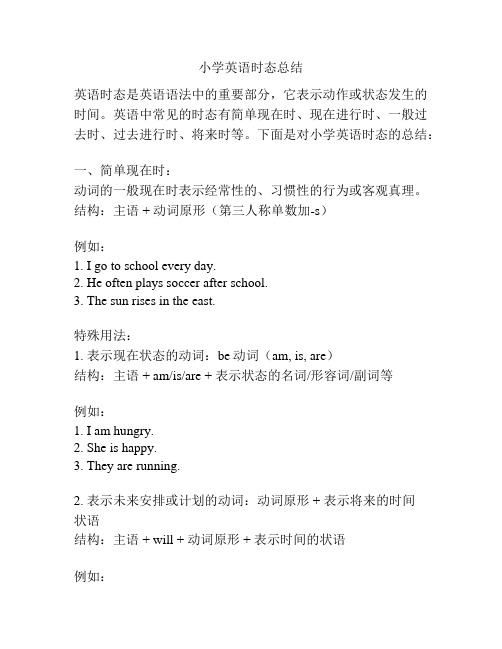
小学英语时态总结英语时态是英语语法中的重要部分,它表示动作或状态发生的时间。
英语中常见的时态有简单现在时、现在进行时、一般过去时、过去进行时、将来时等。
下面是对小学英语时态的总结:一、简单现在时:动词的一般现在时表示经常性的、习惯性的行为或客观真理。
结构:主语 + 动词原形(第三人称单数加-s)例如:1. I go to school every day.2. He often plays soccer after school.3. The sun rises in the east.特殊用法:1. 表示现在状态的动词:be动词(am, is, are)结构:主语 + am/is/are + 表示状态的名词/形容词/副词等例如:1. I am hungry.2. She is happy.3. They are running.2. 表示未来安排或计划的动词:动词原形 + 表示将来的时间状语结构:主语 + will + 动词原形 + 表示时间的状语例如:1. We will have a picnic next Sunday.2. He will go to the movies tonight.3. She will visit her grandparents tomorrow.二、现在进行时:动词的现在进行时表示正在进行的动作。
结构:主语 + be动词(am, is, are)+ 动词-ing例如:1. I am studying now.2. He is playing basketball.3. They are watching TV.特殊用法:1. 表示将来按计划或安排或打算进行的动作结构:主语 + be going to + 动词原形 + 表示时间的状语例如:1. I am going to have dinner with my friends tomorrow.2. They are going to visit the museum next week.3. We are going to watch a movie tonight.三、一般过去时:动词的一般过去时表示过去发生的动作或状态。
小学英语知识点大全,涵盖全部39个知识点!

小学英语知识点大全,涵盖全部39个知识点!小学阶段正是英语学习的黄金阶段,下面我们就针对英语将小学用到的知识点为您整理出来,包括:时态,句型,常用词大全,英语学习需要积累,将本文收藏,日积月累就能有所提升。
1现在进行时表示正在发生的事情或进行的动作,常与now,listen,look等词连用,结构是主语+be动词(am, is, are)+动词ing如:It is raining now 外面正在下雨It is six o’clock now现在6点了My parents are reading newspapers in the sitting room我父母正在客厅看报纸Look! The children are having a running race now看!孩子们正在赛跑问句将be动词移前,否定句在be动词后+not2一般现在时表示经常反复发生的事情或动作,常与often, usually, sometimes, always, every day(week year…) on Sundays等词连用结构是主语+动词原形;当主语为第三人称单数即he,she, it, Tom, my mother, the boy 等词时,动词后加s或es如:We have an English lesson every day 我们每天都要上英语课Do the boys run faster than the girls? Yes, they do男孩比女孩跑的快吗?是的问句借助于do, does否定句借助于don’t, doesn’t,后面动词一定要还原3一般过去时表示发生在过去的事情或存在的状态,常与just now; a moment ago; …ago; yesterday; last ( week; month; year; Monday; weekend); this morning等词连用结构是主语+be动词的过去式(was; were)或主语+动词的过去式注意:be动词与动词过去式不可同时使用如:My earphones were on the ground just now我的耳机刚刚还在呢Where were you last week? I was at a camp你上个星期去哪了?我去野营了What did you do yesterday? I visited a farm你昨天去干嘛了?我去参观农场了问句有be动词将be动词移前,没有be动词借助于did,后面动词还原否定句有be动词在后面加not,没有借助于didn't后面动词还原4一般将来时表示将要打算发生的事情或动作,常与tomorrow, next week(year; Tuesday…), this week( weekend ;evening; afternoon;…)today等词连用。
小学英语时态和语法总结

小学英语时态和语法总结一、现在时态(Present Simple)1. 用法:表示经常性的动作、习惯、常态、真理等。
2. 构成:主语 + 动词原形(第三人称单数要加-s)3. 特殊用法:a) 认真、真诚的祈使句:Be satisfied with your life.b) 当现在是将来动作或安排:My plane leaves in one hour.c) 描述本能或内在特征:The earth moves around the sun.d) 当主语是it,后面是名词从句时:It seems that she knows the answer.e) 表示世界真理或普遍真理:The sun rises in the east.4. 注意事项:a) 第三人称单数动词要加-s。
b) 当主语是第一或第二人称,或者是复数,动词不变。
二、现在进行时态(Present Continuous)1. 用法:表示现在正在进行的动作。
2. 构成:主语 + am / is / are + 动词的现在分词(-ing形式)3. 特殊用法:a) 表示近期打算:I am going to the cinema tonight.b) 表示变化发展的情况:The weather is getting worse.c) 表示接下来安排好的未来动作:I am seeing a movie tomorrow.d) 表示抱怨或责备:You are always misbehaving!4. 注意事项:动词的现在分词的构成规则需要注意。
如:study - studying, play - playing, run - running。
第1页/共5页三、过去时态(Past Simple)1. 用法:表示过去发生的动作或状态。
2. 构成:主语 + 动词过去式3. 特殊用法:a) 表示“过去经常性的动作”:I often walked to school when I was young.b) 表示“在过去的某个时间发生的动作”:I visited my grandparents last weekend.c) 用于条件句中,表示假设:If I had enough money, I would buya car.4. 注意事项:动词的过去式需要根据规则进行变化,如:study - studied, play - played, run - ran。
小学英语语法总结全集

小学英语语法总结全集小学英语语法总结全集一、基本句型1. 主语 + 系动词 + 表语2. 主语 + 动词3. 主语 + 动词 + 宾语4. 主语 + 动词 + 间接宾语 + 直接宾语5. 主语 + 动词 + 宾语 + 宾补6. There be 句型二、动词时态1. 现在时2. 过去时3. 将来时4. 现在进行时5. 过去进行时6. 现在完成时7. 过去完成时8. 将来完成时9. 现在完成进行时10. 过去完成进行时三、名词1. 可数名词2. 不可数名词3. 单数形式4. 复数形式5. 特殊名词的复数形式四、形容词1. 基本形2. 比较级3. 最高级五、副词1. 形容词转换为副词2. 表示方式、时间、频率的副词3. 比较级和最高级的副词形式六、代词1. 主格代词2. 宾格代词3. 物主代词4. 反身代词5. 指示代词6. 疑问代词7. 不定代词七、介词1. 表示位置的介词2. 表示时间的介词3. 表示原因和目的的介词八、连词1. 并列连词2. 选择连词3. 因果连词4. 时间连词5. 让步连词6. 目的连词九、冠词1. 不定冠词2. 定冠词3. 特指用的冠词十、形容词和副词的用法区别十一、固定搭配1. 动词搭配2. 形容词搭配3. 名词搭配以上是小学英语语法的基本知识点总结,针对小学阶段学习英语的学生,这些知识点是非常重要的。
在日常学习和练习中,应该多加复习和巩固,通过大量的练习和实际应用,掌握这些知识点的正确用法,提高语法水平,从而更好地运用英语进行交流和表达。
参考词汇:1. subject [ˈsʌbdʒɪkt] 主语2. verb [vɜrb] 动词3. object [ˈɑbdʒɪkt] 宾语4. complement [ˈkɑmpləmənt] 补语5. countable noun [ˈkaʊntəbəl naʊn] 可数名词6. uncountable noun [ʌnˈkaʊntəbəl naʊn] 不可数名词7. singular form [ˈsɪŋgjələr fɔrm] 单数形式8. plural form [ˈplʊrəl fɔrm] 复数形式9. adjective [ˈædʒəktɪv] 形容词10. adver b [ˈædvɜrb] 副词11. pronoun [ˈproʊnaʊn] 代词12. preposition [ˌprepəˈzɪʃən] 介词13. conjunction [kənˈdʒʌŋkʃən] 连词14. article [ˈɑrtɪkl] 冠词15. phrase [freɪz] 搭配。
(完整版)小学四大时态
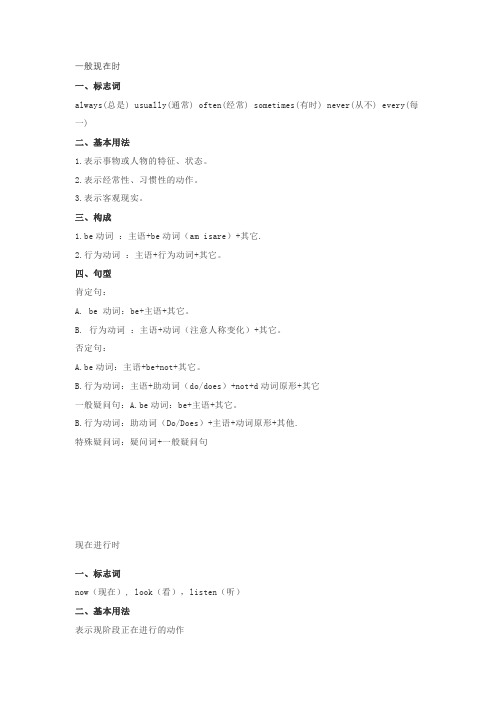
一般现在时一、标志词always(总是) usually(通常) often(经常) sometimes(有时) never(从不) every(每一)二、基本用法1.表示事物或人物的特征、状态。
2.表示经常性、习惯性的动作。
3.表示客观现实。
三、构成1.be动词:主语+be动词(am isare)+其它.2.行为动词:主语+行为动词+其它。
四、句型肯定句:A. be 动词:be+主语+其它。
B. 行为动词:主语+动词(注意人称变化)+其它。
否定句:A.be动词:主语+be+not+其它。
B.行为动词:主语+助动词(do/does)+not+d动词原形+其它一般疑问句:A.be动词:be+主语+其它。
B.行为动词:助动词(Do/Does)+主语+动词原形+其他.特殊疑问词:疑问词+一般疑问句现在进行时一、标志词now(现在), look(看),listen(听)二、基本用法表示现阶段正在进行的动作三、基本结构1.肯定句:主语+be动词+动词现在分词(ing)+其它。
2.否定句:主语+be动词+not+动词现在分词(ing)+其它。
3.一般疑问句:be动词+主语+现在分词(ing)+其它。
4.特殊疑问句:疑问词+一般疑问句。
一般将来时一、标志词tomorrow(明天),soon(不久),will(将要=be going to)二、基本用法表示在在将来某个时间要发生的动作或存在的状态。
三、基本结构1.肯定句:主语 + be going to + 动词原形。
主语+will+动词原形。
2.否定句:主语 + be going to +动词原形。
主语 +won’t + 动词原形3.一般疑问句:Be + 主语 + going to+动词原形Will + 主语 + 动词原形4.特殊疑问句:疑问词+一般疑问句一般过去时一、标志词yesterday(昨天),ago(以前),before(在...之前)二、用法1.表示过去某个时间发生的动作或存在的状态,常和表示过去的时间状语连用。
- 1、下载文档前请自行甄别文档内容的完整性,平台不提供额外的编辑、内容补充、找答案等附加服务。
- 2、"仅部分预览"的文档,不可在线预览部分如存在完整性等问题,可反馈申请退款(可完整预览的文档不适用该条件!)。
- 3、如文档侵犯您的权益,请联系客服反馈,我们会尽快为您处理(人工客服工作时间:9:00-18:30)。
1.动物:cat猫dog狗pig猪duck鸭rabbit兔子horse马elephant大象ant蚂蚁sheep羊donkey驴squirrel松鼠fish鱼bird鸟eagle鹰snake蛇mouse老鼠kangaroo袋鼠goose鹅monkey猴子panda熊猫bear熊lion狮子tiger老虎fox狐狸zebra斑马giraffe长颈鹿rooster 公鸡lion狮子zebra斑马dragon龙swan天鹅hen母鸡cow牛2. 水果蔬菜mango芒果apple苹果banana香蕉pear梨orange桔子watermelon西瓜grape葡萄peach桃子strawberries 草莓lemon柠檬tomato西红柿potato土豆onion洋葱carrot胡萝卜eggplant茄子green bean青豆cucumber黄瓜cabbage卷心菜3. 食物fish 鱼noodles 面条cake 蛋糕tofu 豆腐nut 坚果meat 肉beef 牛肉pork 猪肉sandwich 三明治vegetable 蔬菜rice 米饭biscuits 饼干egg 鸡蛋hot dog 热狗sausage 香肠jam 果酱sweet potato 白薯milk 牛奶cherry pie 樱桃派onion 洋葱chicken 鸡肉oil 油pizza 披萨yogurt 酸奶chocolate 巧克力pork ribs 排骨ice cream 冰激凌sweet and sour fish 糖醋鱼bread 面包meatballs 肉丸子chicken nuggets 炸鸡块fruit 水果a bowl of soup 一碗汤cookies 曲奇a dish 一道菜salad 沙拉green bean 青豆dessert 甜点ketchup 番茄沙司hamburger 汉堡French fries 炸薯条4. 饮料coffee咖啡coke可乐juice果汁milk牛奶water水orange juice橙汁beer啤酒tea茶5. 交通工具bike自行车bus公共汽车train火车boat小船ship轮船yacht快艇car小汽车jeep吉普车plane飞机subway地铁taxi出租车spaceship宇宙飞船6. 颜色red红色blue蓝色yellow黄色orange橘色green绿色pink粉色black黑色white白色brown棕色grey灰色purple紫色silver银色7. 学习用品computer电脑knife小刀pen钢笔pencil铅笔pencil-case铅笔盒pencil-box铅笔盒ruler尺子book书bag书包newspaper报纸schoolbag书包eraser橡皮math book数学书sharpener转笔刀storybook故事书notebook笔记本English book英语书crayon蜡笔Chinese book语文书8. Family Tree家庭成员之间的关系mother母亲father父亲sister姐妹brother兄弟son儿子daughter女儿uncle叔叔aunt阿姨dad爸爸mom妈妈grandfather祖父grandmother祖母grandpa爷爷grandma奶奶cousin堂兄弟姐妹nephew侄子niece侄女9. 用来形容某人的词汇:例:“He is kind.”(他是善良的)clever(聪明的)cute(可爱的)dangerous(危险的)famous(著名的)fine(美好的)funny(有趣的)great(了不起的)lovely(可爱的)nice(和蔼的)shy(害羞的)slow(迟钝的)smart(聪明的)wonderful(奇妙的)10. 体貌特征。
例:“He is tall and strong.”(他高大而强壮。
)还有一些词语是:beautiful(美丽的)dirty(脏的)fat(肥胖的)healthy(健康的)little(小的)old(年老的)pretty(漂亮的)short(矮的)thin(瘦的)ugly(难看的)young(年轻的)11. 职业“He is a lawyer(律师).”。
其他表示职业的单词还有:cook(厨师)dentist(牙科医生)doctor(医生)driver(驾驶员)engineer(工程师)farmer(农民)manager(经理)nurse(护士)policeman(警察)policewoman(女警察)postman(邮差)pupil(小学生)scientist(科学家)singer(歌手)student(学生)teacher(教师)waiter(服务员)worker(工人)pilot(飞行员)professor(大学教授)coach(教练)teacher(教师)barber(理发师)tour guide(导游)writer(作家)12. 体育用品:ball球basketball篮球volleyball排球tennis网球ping-pong乒乓table tennis乒乓球football足球soccer英式足球golf高尔夫rugby橄榄球badminton羽毛球go skating滑冰13. 课程、科目:Chinese语文math数学English英语music英语art美术体育science科学品德computer计算机14. 方位:east东 west西 south南 north北15. 餐具:plate盘子knife 刀fork叉spoon 勺子pot 锅chopsticks筷子16. 地点:home家room房间bedroom卧室bathroom浴室living room客厅kitchen厨房washroom洗手间study书房classroom教室library图书馆bookstore书店playground操场gym体育馆computer room电脑教室music room音乐教室art room美术教室office办公室school学校post office邮局clinic诊所hospital医院shop商店bank银行company公司factory工厂farm农场cinema电影院museum博物馆park公园amusement park游乐园theme park主题公园zoo动物园supermarket超市gas station加油站the Great Wall长城the Summer Palace颐和园the Palace Museum 故宫17. 国家、城市:ChinaAmerica/US/USA Britain/UK EnglandCanadaAustraliaNew YorkLondonSydney18. 服饰:jacket夹克衫shirt衬衫T-shirt T恤衫skirt 短裙dress连衣裙jeans牛仔裤socks袜子shoes鞋sweater毛衣coat外套raincoat雨衣shorts短裤sneakers运动鞋slippers拖鞋trousers裤子sandals凉鞋boots长靴hat帽子cap鸭舌帽tie领带scarf围巾gloves手套suit套装uniform校服blouse女士衬衫pants长裤19. 职业:teacher教师student学生doctor医生nurse护士driver司机farmer农民singer歌唱家writer作家engineer工程师policeman警察pilot飞行员barber理发师lawyer律师professor大学教授coach教练20. 身体部位body身体back后背heart心脏neck脖子tooth牙齿foot足head头face脸hair头发nose鼻子mouth嘴eye眼睛ear耳朵arm胳膊hand手finger手指leg腿knee膝盖toe脚趾21. 人的心理感受happy高兴的,开心的glad高兴的angry生气的sad悲伤的tired累的interested感兴趣的afraid害怕的excited兴奋的22. 患病、身体不舒服ill有病的sick有病的fever发烧hurt受cold感冒cough咳嗽sore throat嗓子疼a runny nose流鼻涕flu流感toothache牙疼headache头疼earache耳朵疼backache腰疼stomachache胃疼pill药片,药丸23. 乐器:flute 笛子violin 小提琴piano 钢琴drum鼓guitar吉他24.形状circle圆diamond菱形square正方形rectangle长方形triangle三角形heart心形star五角星形25. 数词one 一two 二three 三four 四five 五six 六seven 七eight 八nine 九ten 十eleven 十一twelve 十二thirteen十三fourteen十四fifteen十五sixteen十六seventeen十七eighteen十八nineteen十九twenty二十thirty三十forty四十fifty五十sixty六十seventy七十eighty 八十ninety九十hundred百thousand千26. 序数词first 第一second 第二third 第三fourth 第四fifth 第五sixth 第六seventh 第七eighth 第八ninth 第九tenth 第十27. 季节 (season)spring 春天 summer 夏天autumn / fall 秋天 winter 冬天28. 星期( week )Sunday 星期日Monday 星期一Tuesday 星期二Wednesday 星期三Thursday 星期四Friday 星期五Saturday 星期六weekend 周末29. 月份January 一月February 二月March 三月April 四月May 五月June 六月July 七月August 八月September 九月October 十月November 十一月December十二月30. 节日:Teachers’ Day教师节 ---September 10thNational Day国庆节 ---October 1stThanksgiving Day感恩节 ---the fourth Thursday in November Christmas Day圣诞节 ---December 25thNew Year 元旦 ---January 1stSpring Festival 春节Women’s Day妇女节 ---March 8thTree-Planting Day植树节 ---March 12thLabor Day劳动节 ---May 1stMother’s Day母亲节 ---the second Sunday in MayFather’s Day父亲节 ---the third Sunday in June Children’s Day儿童节 ---June 1st31. 天气(weather):sun太阳sunny晴朗的cloud云cloudy多云的rain雨rainy下雨的wind风windy有风的snow雪snowy下雪的hot颜色的cold寒冷的cool凉爽的warm温暖的wet湿润的dry干燥的不规则变化的动词过去式:do/does---did is---was are---were go---went have---had are---were get---got say---saidfeel---felt drink--drank eat--ate bring----brou ghtthink----thou ghtbuy----bought catch---- caught teach ----taughtsit----sat cut----cut put---putbecome----became时态总复习一、【一般现在时】1. 表示经常发生或反复发生的动作。
